Laboured Progress
When I last left you, I was clawing my way to make at least some progress on the build and am pleased that on several fronts, some laboured progress has been made. Unfortunately, nothing that has resulted in actually starting on any major tasks, just a general movement forward on getting several fronts closer to execution.
HRV – I was able to get an empty shell of the heat recovery ventilator from Eneready and have temporarily supported it in its final location. This allowed me to plan the ducting runs. Unfortunately, much of the previously planned routes for the ducts would not work due to changes between the ideal ‘paper’ plan and the reality of the framing and plumbing. My original plan had the runs elbowing right of the HRV unit, BUT best practice requires 36″ straight run of the unit before the first fitting.
I also found that a couple of plumbing runs, due to required slope, were not as high as anticipated in the model and therefore were cutting through the planned ducting route. So this required a complete rethink of where the big 7″ diameter ducts were going to go. I was adamant I did not want to install any bulkheads as is prevalent in the HVAC industry. I fortunately had planned on dropped ceilings in the kitchen and main floor bathroom, and was able to route through these areas to bypass the major plumbing obstructions.
After drawing up the new routing and meeting with Patrick Summer, my HRV consultant, I started looking for vendors to provide the needed components. Both Patrick and Eneready had stressed the importance of reducing the equivalent length of fittings as much as possible which is the equivalent length of straight duct an elbow represents due to the turbulence caused by the change of direction. I unfortunately took this issue to be not just the turn in direction, but also the roughness of the inside surface of a standard gored elbow. This set me off on a tangent looking for smooth wall or ‘die formed’ elbows. I contacted several manufacturers in the USA (these elbows are not available locally) and had settled on www.stampedfittings.com. They had great customer service and reasonable pricing. While the order was being finalized, I asked Eneready for any information on the improvements a smooth wall vs a gored wall fitting represents. They did have this specific info but provided a chart that shows the vast improvements gained when you increase the centre line radius (CLR) of the elbow. This motivated further research on the web and I came across the below chart at www.spiralmfg.com.
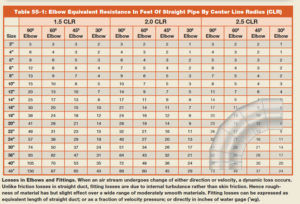
First of all, notice the difference between elbows with a 1.5 centre line radius (CLR) and a 2.0 CLR. For instance, a 6″ 90 elbow with 1.5 CLR represent 12 FEET!! of equivalent duct length where a 2.0 CLR only represents 7′. Also note in the footer “Unlike friction losses in straight duct, fitting losses are due to internal turbulence rather than skin friction. Hence roughness of material has but slight effect over a wide range of moderately smooth materials.” So that shot down my emphasis on smooth wall elbows. As long as the gores are sealed to prevent air leakage, they will represent no significant increase to pressure drop over a die formed elbow (see table 51-1 and 52-1 in the provided link).
As the fittings I was about to order were 1.5 CLR, I cancelled the order and will instead look for some local gored fittings that are 2.0 CLR or ‘long radius’. I am also waiting on a quote from Eco Supplies for the rest of the ducting components.
Basement Slab – With the help of John from Embers, I have finished the final grade of the gravel in the basement in preparation of the sub slab insulation. I now only need to identify the portions of the slab that will slope to drain and grade these areas down to the drain stub.
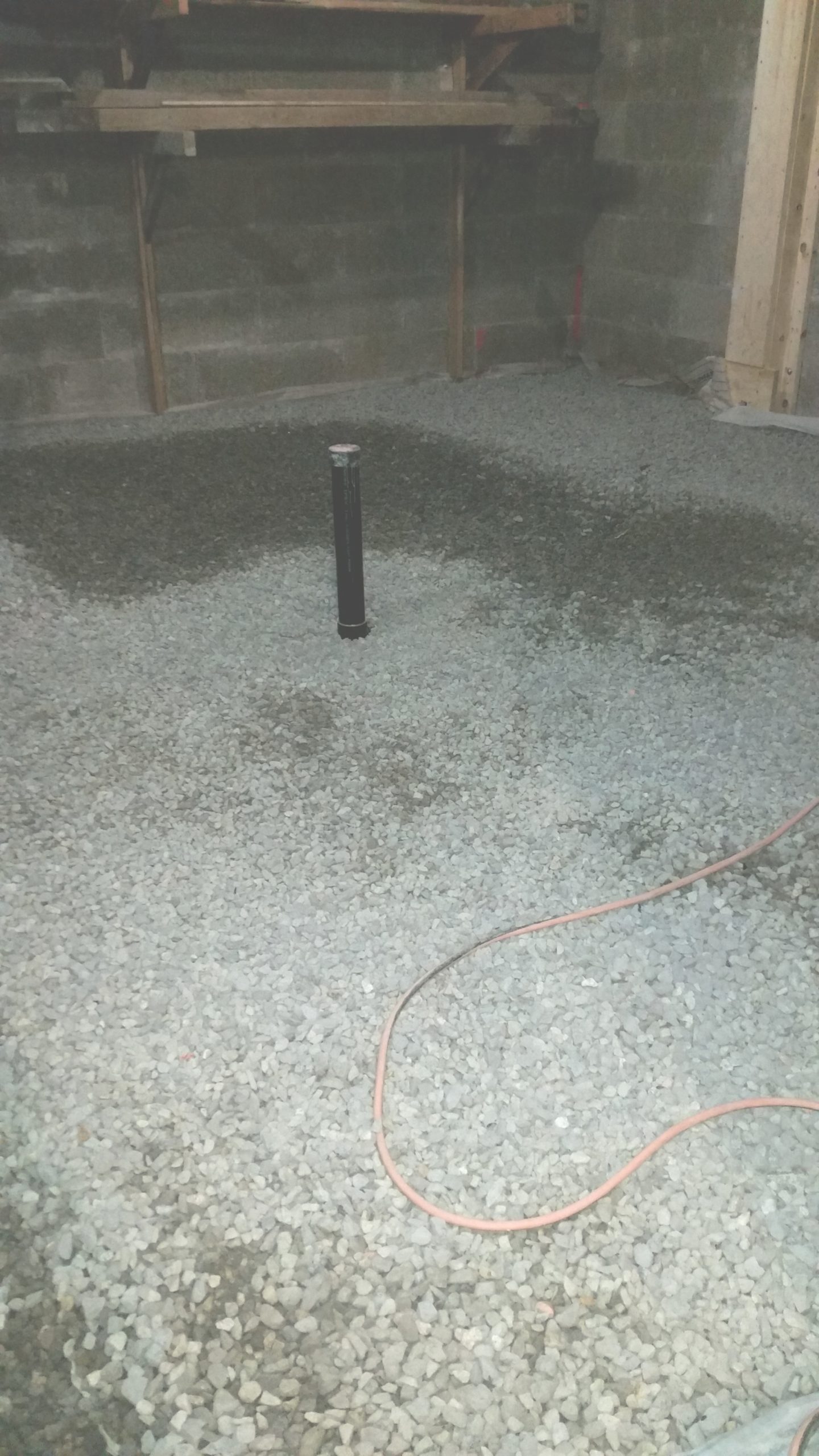
I have also chosen the vapour barrier/soil control membrane for below the slab. The building code only requires 6 mil poly to be used below a slab, but this is easily damaged and not the best at soil gas control if present. Best practice dictates a 12 or 15 mil barrier and I will be using the 15 mil PERMINATOR® Under slab Vapour Barrier from W.R. Meadows and sold through National Concrete Accessories in our area. Another option is Stego Wrap, but the slightly larger area covered by the Perminator rolls worked better for my scope preventing the need to buy two rolls. Just remember, the membrane ALWAYS goes above the insulation directly below the concrete slab.
With the help from Graham (RDH) and Jason (SMT), I have also finalized the sub-floor-slab insulation lab. This lab will analyze the wetting of XPS, EPS, and Mineral wool insulation in the humid environment that exists below the slab and look at the thermal resistance losses associated with any wetting.
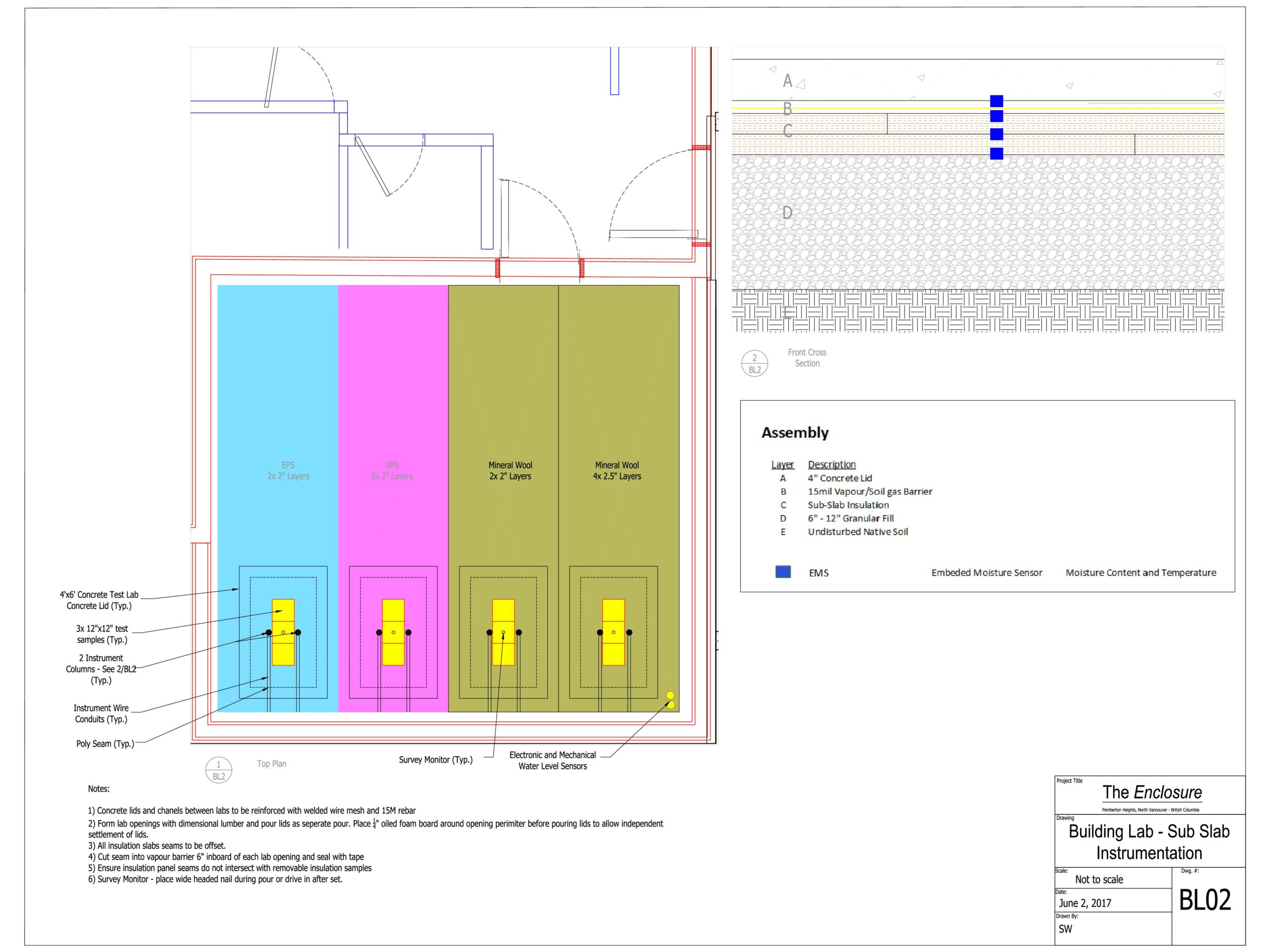 Cladding – A lot of time has been put into planning the various aspects of the exterior finishing of this dwelling.
Cladding – A lot of time has been put into planning the various aspects of the exterior finishing of this dwelling.
I finally found a source for the long screws needed to attach the furring strips that form the rain-screen capillary break, through the 6″ of insulation, into the studs. Several people had suggested Leyland Fasteners, but after several inquiries, they failed to respond and their website did not show they carried the required counter sunk tapered head needed. I reached out to my ‘team’ and was directed to Small Planet Supply. I ordered 33 boxes of the 8×220 mm Heco Topix Stainless Steel Tapper Head screws. The stainless screw represents a significant reduction in thermal transfer vs a carbon steel screw and should easily pay for itself in a few years.
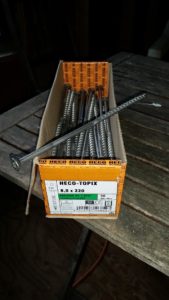
I am also working through getting sources for the cedar T&G horizontal strip siding. My original plan was to use an engineered siding from Coulson Cedar. They had a product that was a 1/4″ veneer of old growth cedar attached to a softwood plywood. This was very economical and represented a lot less risk of warping and cracking. However Coulson stopped making that product because their key market, California, has termites, and they loved the soft wood base. So now they still make an engineered cedar, but it is now 100% cedar which I will consider. I have also received quotes from Coastal Cedar Direct and Sound Cedar Lumber. I now need to sit down and analyze the products and pricing once doing a firm takeoff for the project. We will clad the majority of the house with the cedar and will create a few ‘feature’ walls at the front of the dwelling with a yet to be chosen panelized product (probably some type of cement board).
I have an enquiry with my lumber supplier – Standard Lumber – for some pressure treated plywood 3/4″ x 3″ furring strips. I would much rather have strips manufactured and treated to this dimension than have to rip down plywood and treat on site. But we will see if available and pricing.
I also met with my flashing guru and BCIT instructor James (RDH) to go through the flashing strategy for the different interfaces on the dwelling. It was a productive meeting and I hope to move forward on ordering in the next few days. I will post more information once I start installing.
The one area that continues to be a problem without a solution is where the insulation aboard of the foundation continues above grade. For our project, there is about 6″ of concrete exposed above grade. This is a vulnerable location as it is highly susceptible to mechanical damage (especially when there is a sidewalk against the dwelling as I have). It is also a wet zone and so wood would rot and metal flashing would corrode. There really is no elegant solutions on the market at this point. Many use a form of concrete board, but this is in contravention of the manufacturers who state their boards must be at least 6″ above grade and will break down in this usage. Some will stucco this strip, but my research has shown that this often cracks. My guru’s at RDH both recommended CT Board which is rigid foam capped with a mortar. However we have a LOT of ants on the property and they would just love the foam (one large reason I did not use it on outside of foundation). Others have clad this strip with stone or brick, but if this is the only area on the house to have this finish, the 6″ strip would look silly with this treatment. We have decided that the cement board offers the best option and I am now determining a way to mount it that will allow easy replacement down the road. I will post more info as available.
Insulation – I am pleased to say that I have received the next major instalment of ROCKWOOL mineral wool that will be installed on the outboard side of the exterior walls. I am grateful for ROCKWOOL’s continued generosity in sponsoring this project in support of the building science labs being incorporated into the finish dwelling. This time I rented a telehandler and unloaded the 53′ trailer and stuffed 16 pallets of ComfortBoard 80 into the garage. It was an emotional day as the last time the ‘ROCKWOOL’ truck showed up in May 2015, I fell badly and broke my left arm where it attaches to the shoulder. It will need surgery at some point, but I have been living with it till I finish the build. So I was on high alert on the delivery day this time.
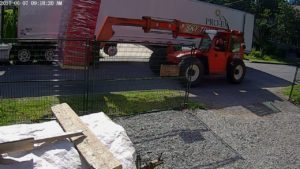
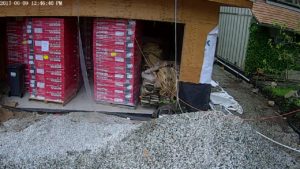
SO – the stars are very slowly aligning to the point where I can start on the exterior insulation and cladding, HRV system, or basement slab on grade. Hopefully I will be able to advance all three using some labour and some longer days and weekends. Keep your fingers crossed.
Thanks for visiting.
“What we do today, right now, will have an accumulated effect on all our tomorrows. ” —Alexandra Stoddard Author
“It is not only for what we do that we are held responsible, but also for what we do not do.” —Moliere (1622-1673) French Playwright, Actor
“Learning is not attained by chance, it must be sought for with ardor and attended to with diligence.” —Abigail Adams (1744-1818) U.S. First Lady (1797 1801)
“I am always doing that which I cannot do, in order that I may learn how to do it. ” —Pablo Picasso (1881-1973) Spanish Artist

Why treated furring strips? rot should be minimal if any as they are behind the cladding.
Hi Anonymous – Fast answer is that it is a code requirement. Yes – there should not be any significant bulk water entry into this space (rain entry). However, this is far from a dry cavity. In the wintertime, spring, and fall, the RH in this cavity will be consistently around 90%. This will lead to increased wood moisture percentages to the levels that could cause fungi growth. In the summer, reversed solar drive could cause high humidity levels as the sun comes out after a rain and drives the moisture through the cladding. The code and best practice also require corrosion resistant fasteners. You can use coated steel or stainless steel. The later also significantly reduces the thermal bridging associated with these through cavity fasteners.